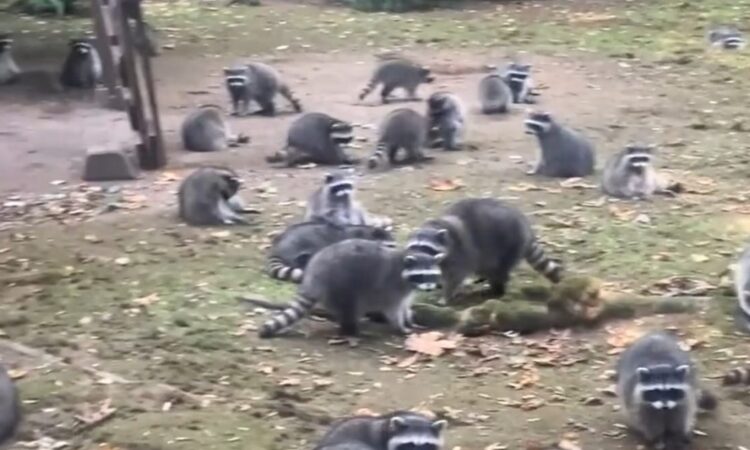
This story has been updated to add a video.
A North Kitsap woman who says she’s fed wildlife for decades called 911 for help last Thursday afternoon after being surrounded in her home by an estimated 100 raccoons.
The raccoons can be seen milling around a backyard in a video posted to social media Monday afternoon by the Kitsap County Sheriff’s Office. According to a KCSO report a deputy at the scene estimated there to be up to 100 individual animals at the property just off Miller Bay Road and Sid Price Road, in unincorporated Kitsap County just a few miles north of Suquamish.

In the video, a deputy is heard speaking to the woman, and she admits that the large numbers of raccoons began gathering in her wooded backyard around six weeks ago. The woman had told deputies she has been feeding raccoons on her property for more than 38 years, according to KCSO spokesman Kevin McCarty, but had never seen them in such large numbers and they only recently became aggressive.
“She said the normal raccoons are nice, but the new ones scare her,” McCarty said, reading from a deputy’s statement in the report.
The woman had told a deputy that raccoons have recently swarmed her until they were fed anytime she attempted to leave her home, and she would throw food to them, according to McCarty. The woman also told deputies that the raccoons approach the home and scratch on windows or walls at all hours of the day. That day she wanted to get away from the property, and after deputies arrived after 1 p.m. the homeowner was able to leave in her car. The deputies said the raccoons were not aggressive at the time.
Kitsap County 911 called the Washington Department of Fish and Wildlife, which referred the woman to its “wildlife control operators” program, which essentially connects residents to private trappers who are certified to deal with small animals. WDFW spokeswoman Bridget Mire noted that “All animals trapped by a WCO must be released on-site or euthanized and properly disposed of,” citing the state code that governs wildlife control operators.
“I wouldn’t say its common, but feeding wildlife is a common problem we deal with,” Mire said Monday, and cautioned residents against feeding wildlife for many reasons. She said when wildlife congregates around an unnatural food source it can cause disease to spread, lose their sense of caution around people or attract predators that can then interact with human residents.
“We want them to stay wild, and not get comfortable with people,” Mire said.
McCarty said there is no indication the woman was doing anything illegal by feeding racoons, and Mire said some municipalities or counties in the state do have ordinances against feeding wildlife. State law only applies to larger carnivores that cannot legally be fed by individuals.
For more information about avoiding conflict with raccoons and other wildlife, visit the Washington Department of Fish and Wildlife homepage.
